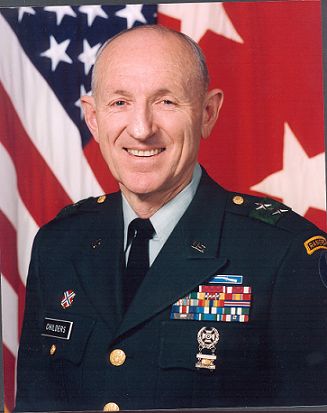-

-
MajGen CarrollDChildersUSA (Ranger) (Ret), Fredericksburg, VA
Director
MAJOR GENERAL CARROLL D. CHILDERS
Retired effective Aug 15, 1999
Carroll D. Childers was an Enlisted Soldier in the Army National Guard for 9 years before getting commissioned as a 2LT by the Virginia National Guard Officer Candidate School in 1964. He progressed through the officer ranks, serving in Armor and Armored Cavalry for 25 of his 44 years of service before converting to Infantry. Commanding at every level of Tactical Command (Platoon, Company, Battalion, and Brigade), Major General Carroll D. Childers assumed command of the 29th Infantry Division (Light) on 1 August 1996: the Commanding General of the only light division in the Reserve Components. In this assignment, he exercised command and control over units in Virginia, Maryland, Massachusetts, Connecticut and New Jersey, with an authorized strength of 11,195 personnel which included Infantry, Artillery, Aviation, Combat Engineer, and the very important Combat Service Support elements.
The General is a graduate of the US Army Ranger Course and after the second attempt earned the Expert Infantry Badge. Prior to Division Command, he commanded the Armored Cavalry Troop for 5 years, the 3rd Battalion 116th Infantry for 2 years, the Virginia Army National Guard Troop Command 3 years, the 2nd Brigade 29th Infantry Division 5 years, and served as the Assistant Division Commander for Maneuver in 29th Infantry Division 3 years. He also held senior staff positions at state headquarters level including Assistant Adjutant General and Commander, Virginia State Area Command. MG Childers attended the US Army RANGER Course at age 42 and remains the oldest graduate yet to be designated as the Distinguished Honor Graduate. Major General Childers was also the Distinguished Honor Graduate of his OCS Class. He continues to refer to his most enjoyable service as those 19 OCS Classes where he served as an instructor of tactics and the 10 years he spent as a shooter on the Virginia High Power Rifle Team.
In his career, MG Childers has trained from Louisiana (Polk) to New York (Drum); from VA (Pickett & Hill) to CA (Irwin); from Iceland to Germany: all climes, all conditions.
EDUCATION:
Louisiana Polytechnic Institute – BS Degree – Mechanical Engineering
U. S. Army War College Resident Course
Systems Acquisition Course, Defense Systems Acquisition College
Continuing Education Courses to maintain proficiency as a licensed Professional Engineer
MAJOR AWARDS AND DECORATIONS:
Legion of Merit
Meritorious Service Medal
Army Commendation Medal (with 1 Bronze Oak Leaf Cluster)
Army Reserve Component Achievement Medal (with 4 Bronze Oak Leaf Clusters)
National Defense Service Medal
Armed Forces Reserve Medal (with 1 Silver Hour Glass Device)
Army Reserve Components Overseas Training Ribbon
Expert Infantryman Badge (EIB)
Army Service Ribbon
Ranger Tab
CIVILIAN OCCUPATION:
MG Childers worked for the Department of Navy for 38 years, retiring as a GM-15 Mechanical Engineer while working for the Office of Naval Research (ONR) in Roslyn VA in 2000. About 28 of these years was spent as an employee of the Naval Surface Warfare Center, Dahlgren VA while about 10 years was spent working for the United States Marine Corps Quantico VA. A reorganizational relocation to the ONR brought on the decision to retire and become a consultant. In this 38-year career, he received numerous awards for performance to include patents and service in combat zones as a DOD Civilian conducting Research Development Test and Evaluation at the point of the spear with forces in contact with the enemy.
Four months was spent in Vietnam in 1968 with the Brown Water Navy in the Mekong Delta where he introduced numerous concepts to improve the survivability and effectiveness of both watercraft and special operations forces. Four months were spent during 1969 with the USMC in I Corps (Northern Tactical Zone) supporting both air and ground forces with engineering solutions to issues. He returned overseas to support the Navy during their tactical operations in the Persian Gulf during 1988 and finally he served as the Science Advisor to the CG First Marine Expeditionary Unit during Operation Desert Shield and Desert Storm.
For these periods of service as a DOD civilian in a combat zone, he received appropriate civilian recognition.
He consulted independently in the heavy construction industry and for clients of the Department of Defense for 10 years following DOD retirement and currently pursues subjects which may be of interest to DOD sponsors in the near future.






